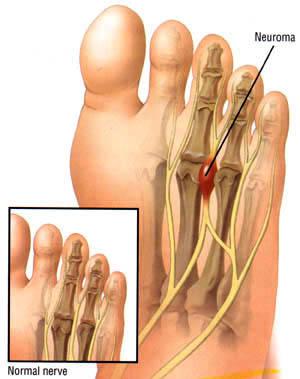Morton's Neuroma surgery

A Morton's neuroma causes pain and numbness in the toes and forefoot and most commonly occurs between the 3rd and 4th toes. In some cases, the pain may also radiate out to the toes. It can also feel like cramp, pins and needles or electric shocks and settles after a few minutes once shoes are taen off. Classically, there is no pain when barefoot and is often worse when the feet are squeezed in shoes.
This surgery involves excising (cutting out) the nerve. This is performed through an incision over the back of the forefoot, between the corresponding metatarsal heads (knuckles).
Surgery for Morton's neuroma is very successful, but surgery of any kind should only be undertaken after non-surgical alternatives have been tried and this condition often responds well to treatment with steroids. Surgery may be recommended if you have severe pain in your foot or if non-surgical treatments don't relieve the discomfort.
Surgery is usually carried out under local anaesthetic, on an outpatient basis, which means you won't need to stay in hospital overnight. The operation can take up to 30 minutes. If the nerve is removed, the area between your toes may be permanently numb.
Risks of surgery
Infection
Any incision can become infected. It is essential that the foot is kept elevated after the operation, for 1 week. If the foot does become infected, this can normally be treated with a short course of oral antibiotics. Very rarely, further surgery is required.
Numbness
The intention of the surgery is to remove the nerve / neuroma. This will cause permanent numbness of the toes. With time the area of numbness will reduce a little.
Recurrence
There is approximately a 5% risk of the symptoms and neuroma recurring in time. Some of these cases will require further surgery.
Failure to relieve all symptoms
The neuroma may not be the only cause for the pain. Any residual pains are usually due to problems within the neighbouring metatarsophalangeal joints. These pains are usually relieved with insoles.
Recovery from surgery
Following the surgery, a bulky dressing is applied and a post operative shoe. It is essential that the foot is kept elevated for 1 week (apart from a small amount of essential walking around). The dressing should be replaced at your GP practice, in 3-4 days. The post operative shoe can be discarded after 2 weeks.
It can take up to four weeks to make a full recovery.
“And do tell Mr Rosenfeld the foot has been perfect even on my walking holiday - no swelling, no pain, and i’ve been back doing sport on it for about 3 weeks now. I’m amazed how easy the recovery has been, and how effective the operation.”
Alison
Activity and time off work
In general (though it varies between individual cases) up to 2 weeks off work is required for sedentary posts. 4 weeks for standing or walking posts.
Follow up
- See Gp at 3-4 days for change of dressing
- Post Op shoe for 2 weeks
- See in Outpatients 2 weeks in Mr Rosenfeld's clinic